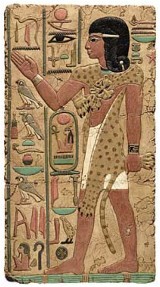Ancient Egypt
Temples and Priests
History >> Ancient Egypt
Why did they build temples?
The pharaohs of Egypt built the temples as houses for the Egyptian gods. Inside the temples, priests performed rituals in hopes of gaining the favor of the gods and to protect Egypt from the forces of chaos.
There were two main types of temples built in Ancient Egypt. The first type is called a Cultus temple and was built to house a specific god or gods. The second type is called a Mortuary temple and was built to worship a dead pharaoh.

Relief painting of a priest
by Unknown
Over time, the temples of Ancient Egypt grew into large complexes with many buildings. At the center of the temple was the inner chambers and the sanctuary which housed a statue of the god. This is where the high priest would hold rituals and give offerings to the god. Only the priests could enter these sacred buildings.
Around the sanctuary, other smaller rooms would hold lesser gods and companions to the primary god of the temple. Outside the inner chambers would be other buildings including large halls filled with columns and open courts. The entrance to the temple often had tall pylons that served as guardians to the temples.
Priests
Working in the temples were the priests and priestesses. There was typically a high priest that was assigned by the pharaoh. The high priest performed the most important rituals and managed the business of the temple. Working as a priest was considered a good job and was a sought after position by wealthy and powerful Egyptians.
Priests had to be pure in order to serve the gods. They washed twice a day, shaved their heads, and wore only the cleanest linen clothing and leopard skins.
Rituals
Priests performed daily rituals in the temples. Every morning the high priest would enter the sanctuary and anoint the god's statue with sacred oil and perfume. He would then put ceremonial clothing and paint on the statue. After that he would make offerings of food such as bread, meat, and fruit.
Other rituals and offerings would be made throughout the day in shrines outside the inner sanctuary. Rituals sometimes included music and hymns.
Festivals
Throughout the year, the temples would celebrate events with festivals. Many festivals were open to the local people and not just the priests. Some of the festivals involved large processions where one god would visit the temple of another god.
Economics
The larger temple complexes were major economic hubs in Ancient Egypt. They employed thousands of workers to supply food, jewelry, and clothing for the offerings as well as the many priests. The temples often owned land and collected grain, gold, perfumes, and other gifts from people wanting to earn the favor of the gods.
Interesting Facts about the Temples and Priests of Ancient Egypt
- Columns and pillars in the temples often were designed in the shape of sacred plants such as papyrus and lotus. These plants were believed to grow on the mythical Island of Creation.
- Sometimes priests served as judges for the local people.
- The temples grew in size over time as new pharaohs added to them. Some temples started out as small shrines in early Egyptian history and ended up as large complexes by the end of the New Kingdom period.
- The high priest was a powerful person in both Egyptian society and the government.
- Grain surpluses held by the temples helped to feed the people during times of famine.
- Take a ten question quiz about this page.
- Listen to a recorded reading of this page:
More information on the civilization of Ancient Egypt:
Works Cited
History >> Ancient Egypt


